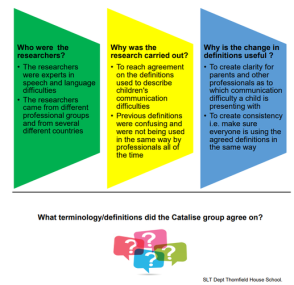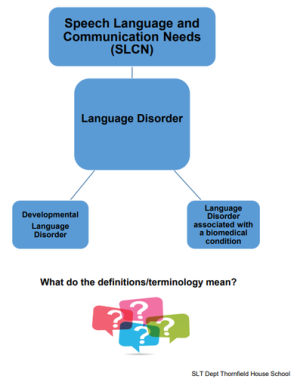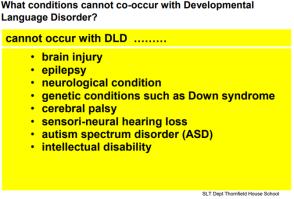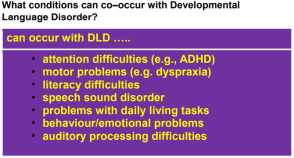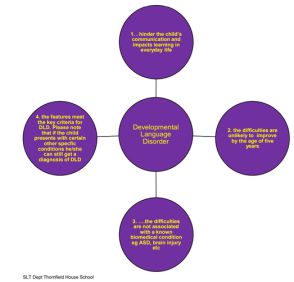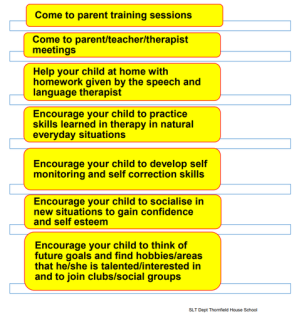Understanding Children with Speech, Language and Communication Needs (SLCN)
The Catalise Research Study 2016/2017
In 2016/2017 the terminology/definitions used to describe children’s speech and language difficulties was reviewed following a study carried out by a group of researchers called the Catalise consortium.
The Definitions/Terminology Explained
Speech, Language and Communication Needs (SLCN)
A wide term that covers all of the different types of speech/language and communication difficulties a child may present with. A child can have one, or more than one type of communication difficulty e.g. a co-occurring SSD. SLCN can also be used as a more general diagnosis in the early stages of a speech and language therapy assessment as the therapist carries out tests, gathers information and consults with other professionals. A diagnosis of SLCN may change to a more specific diagnosis as more information about a child’s difficulties emerge. Please see the following diagram outlining different types of SLCN. This diagram is based on information from the Royal College of Speech and Language Therapist’s (RCSLT) fact sheet on SLCN.
SLT Dept Thornfield House School
Speech Language and Communication Needs
(Ref: Royal College of Speech and Language Therapists (RCSLT) fact sheet on SLCN)
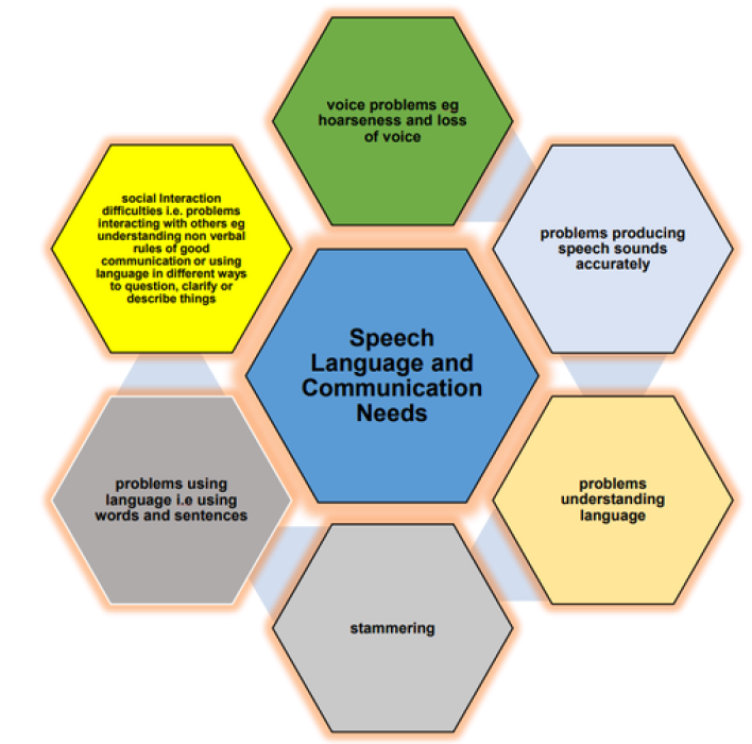
Language Disorder
This term describes a child with Speech, Language and Communication Needs whose communication difficulties are affecting the child …….
• socially
and
• educationally
and these problems are becoming difficult to resolve
With more specific information available a language disorder can be further diagnosed as either …..
• Developmental Language Disorder (DLD)
or
• Language Disorder Associated with a Biomedical Condition
In more detail, these two conditions can be further outlined in the following diagrams:
SLT Dept Thornfield House School
Language Disorder Associated With .....
Here the language disorder occurs as part of a complex condition indicating a specific type of treatment as outlined below.
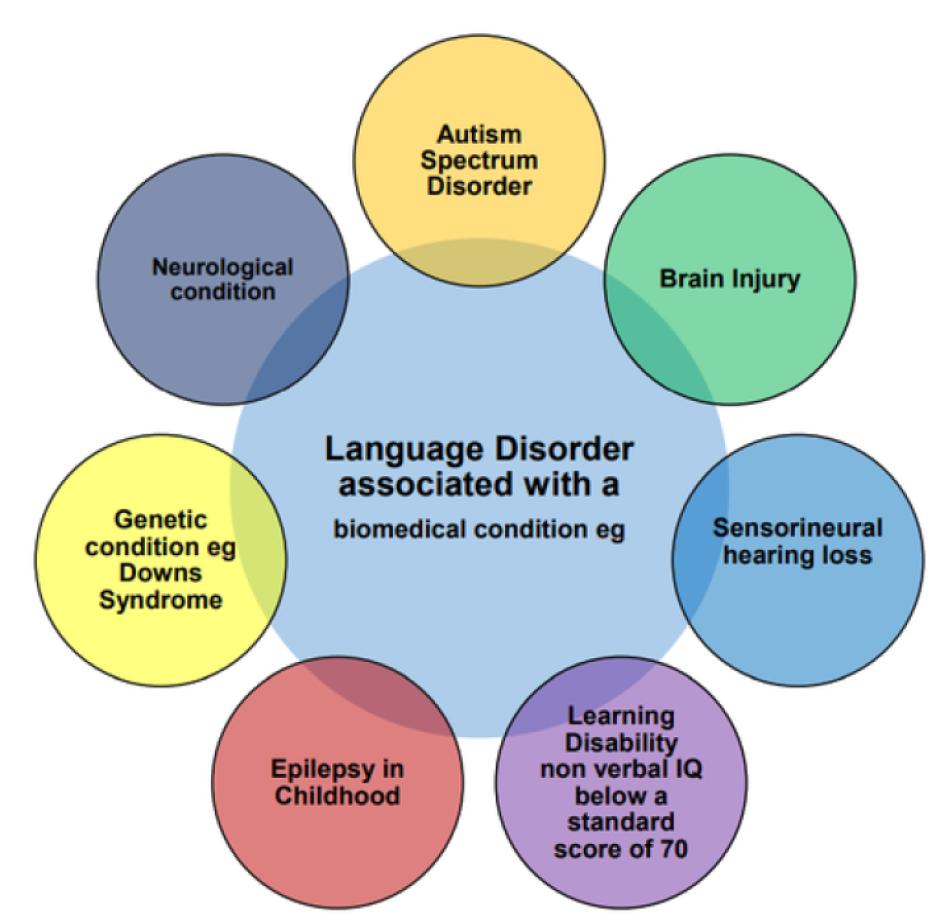
So for example if a child presents with a diagnosis of Autism Spectrum Disorder then the child’s diagnosis is likely to be Language Disorder Associated with Autism Spectrum Disorder etc.
SLT Dept Thornfield House School
Developmental Language Disorder (DLD)
The term Developmental Language Disorder or DLD is used when a child has language difficulties that …
Speech Sound Disorder (SDD)
SLT Dept Thornfield House School
What does it mean?
A wide term for all of the different types of speech problems a child may present with. A child can present with unclear speech for several reasons and may have one, or more than one, type of speech sound difficulty causing the speech sound problem.
The speech difficulty can be mild, moderate or severe.
Each child can be impacted in various different ways.
A SSD can sometimes cause difficulties with reading and spelling.
What are the main types of speech sound disorder that a child may present with?
An Articulatory/ Phonetic Problem:
A speech difficulty caused by a physical problem moving the speech articulators correctly (i.e the lips, tongue, palate, lungs etc e.g. a cleft palate)
Developmental Verbal Dyspraxia (DVD)/ Childhood Apraxia of Speech (CAS):
A speech sound coordination problem. The brain sends an incorrect message about how and when the muscles in the throat and mouth should move to make speech sounds. This will result in the production of the wrong sounds and causes speech intelligibility issues.
Phonological Difficulties:
A speech difficulty caused by a poor ability e.g.…..
- to perceive the fine differences/sound features between similar sounds e.g. t/d p/b, noisy/quiet sounds, front/back sounds etc and/or ….
- to play about with sounds in words e.g. rhyming, segmenting, blending etc
This can lead the child to have difficulties acquiring the internal rule system (phonological rule system) by which we learn to acquire speech. If phonological awareness continues to be weak, speech sounds may not develop when expected leading to speech production problems. Reading and spelling may also be effected.
What is the role of the Speech and Language Therapist in helping a child with SLCN?
References
- RCSLT Briefing Paper on Language Disorder with specific focus on Developmental Language Disorder January 2020
- Bishop, D. V. M., Snowling, M. J., Thompson, P. A., Greenhalgh, T., & The CATALISE Consortium. (2016). CATALISE: a multinational and multidisciplinary Delphi consensus study. Identifying language impairments in children. . PLOS One, 11(7)
- Bishop, D. V. M., Snowling, M. J., Thompson, P. A., Greenhalgh, T., & The CATALISE Consortium. (2017). Phase 2 of CATALISE: a multinational and multidisciplinary Delphi consensus study of problems with language development: Terminology. Journal of Child Psychology and Psychiatry, in press
- Bowen Caroline (2009) Children’s Speech Sound Disorders Wiley- Blackwell


